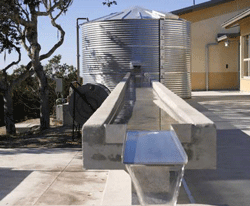Designed With “Green” in Mind
Chartwell School, an independent day school serving grades K through 12, has demonstrated its dedication to reducing greenhouse gas (GHG) emissions through its leadership in high performance school design and operations. Chartwell is committed to creating the best possible learning environment for students by providing exceptional daylighting, outdoor views, good indoor air quality, and thermal comfort. The campus is energy efficient, conserves water, is healthy, comfortable, well lit, and contains the features needed for quality education.
In 2006, Chartwell School was recognized as the first educational campus to receive a Leadership in Energy and Environmental Design (LEED) certification at the Platinum level from the United States Green Building Council. The campus also won an esteemed environmental honor for Sustainable Practices and Facilities during the 2007 Governor’s Environmental and Economic Leadership Award (GEELA) ceremony. In 2009, two green modular buildings were added to the campus to serve the high school students. These buildings are designed in accordance with the Collaborative for High Performance School (CHPS) standards for portable classrooms.
Chartwell maintains active recycling, composting and green cleaning programs. They also incorporated recycled, sustainably produced, and low or no VOC materials throughout the campus and in the facility operations to achieve a high level of sustainable design. These building materials inspire students and the community and also helped generate support and private funding.
How Did Chartwell School Save Energy?
Chartwell reduces energy use to the maximum extent possible. Much of the electrical demand is supported by energy generated from roof-mounted photovoltaics. Although Chartwell was designed with the goal of Net Zero Electricity use, the 32 kilowatt PV system supports 60% of the electricity needs on-site. While the PV system has enhanced student learning, electricity use has been higher than expected when the school was originally designed. As a result, the school is working hard to reduce its energy use and striving toward the Net Zero Electricity use goal.
How Did Chartwell Conserve Water?
To conserve water, Chartwell installed water-conserving fixtures such as waterless urinals and dual flush toilets. An 8,700 gallon rainwater harvesting tank was installed to collect water during storms, which is used to flush toilets on campus. These features alone help the campus to reduce water usage by 60% as compared to a typical school. Chartwell also provided landscaping with native and food-producing plants and natural drainage, with a small organic garden plus 12 large stock tank window gardens as part of their gardening/culinary arts/nutrition program.
How Did Chartwell Use their School as a Learning Tool For Students?
By making the high performance design strategies a visible part of the students’ education, Chartwell is able to use the site as a teaching tool. When completing the construction of the new campus, Chartwell intentionally left the structure exposed. By allowing students to see the structure, it has helped them to learn about engineering. Every year, students (in 8th grade) are challenged by a model bridge competition. Some of the competitors modeled the triangular bracing for roof support to win the competition.
The school is utilized in every way possible to support the curriculum. Students have measured the nature trail that circles the campus as part of their study of perimeters. They have used the weather station data when learning to make graphs. Science students use different aspects of the campus in every unit they study: weather, watersheds, wind blowing across the campus, solar energy, passive solar heating, and solar ovens when studying electricity and alternative energy.
Chartwell School has shown that schools can be healthy, comfortable, and efficient while also being LEED certified and environmentally informative.
"Using life cycle cost analysis, the high performance, green features of our new campus will more than pay for themselves. They will also enhance learning outcomes for students, today and for many years to come." - Douglas Atkins, Executive Director, Chartwell School

A Certified LEED Platinum, independent day school for grades K through 12th.
Climate Actions
- Provides exceptional daylighting, outdoor views, and thermal comfort
- Landscaped with native and food-producing plants using natural drainage
- Incorporates recycled, sustainably produced, and low or no VOC materials
- Reduces energy use with efficient technologies and roof-mounted photovoltaics
- Uses natural ventilation for cooling and to maintain excellent indoor air quality
- Conserves water with a cistern and water-conserving fixtures
- Maintains active recycling and green cleaning programs
- Uses the site as a teaching tool
Upfront Cost Associated with Climate Action
- $312/square foot total construction costs
- 9.2% upfront premium over new construction
Estimated Annual Cost Savings
- $53/square foot savings in operating costs
- 9.4% savings over new construction with lower operating costs
